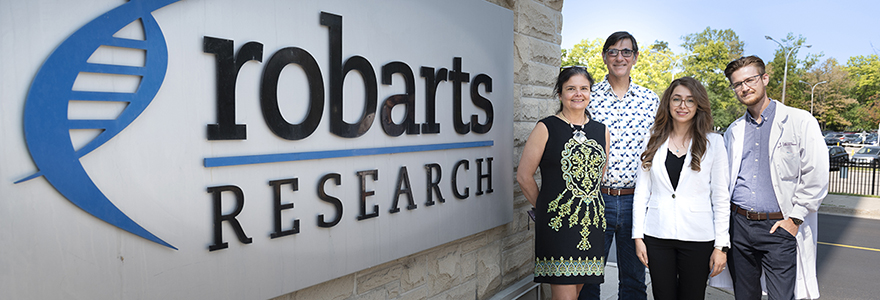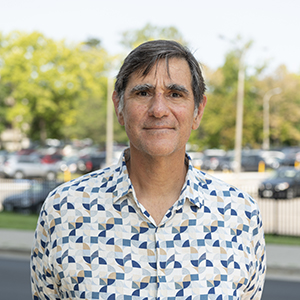Research: Guardians of the cell that become dysfunctional in Parkinson’s disease provide clues for new treatments

The research team: Dr. Vania Prado, PhD, DDS Full Professor , Dr. Marco Prado, Dr. Anoosha Attaran, Post-Doctoral fellow and Vlad Novikov, graduate student (PhD)
By Communications
Through a global collaboration of researchers, Marco Prado, PhD, and his team have developed a better understanding of how a protein called alpha-synuclein interacts with a cellular defense mechanism known as the chaperome. The chaperome is made up of a set of proteins, or chaperones, that guard brain cells against toxic protein buildup.
Alpha-synuclein is thought to be a leading culprit in the development of major neurological disorders, including Parkinson’s disease, Dementia with Lewy bodies, and Alzheimer’s disease.
“Alpha-synuclein is critical to these diseases,” said Prado, a professor in the Departments of Physiology and Pharmacology, and Anatomy & Cell Biology at Schulich School of Medicine & Dentistry, and a Scientist at Robarts Research Institute. “But we don’t know much about how alpha-synuclein is regulated and how the chaperome, which is tasked with protecting brain cells, may participate in preventing alpha-synuclein toxicity.”
Normally, alpha-synuclein regulates brain cell communication, but in diseases, such as Parkinson’s, the protein loses its form and accumulates into toxic bodies that disrupt the flow of communication in the brain.

The team’s work has been published in Acta Neuropathyologica.
As Prado said, “It takes a village to do this work.”
Collaborator Hermona Soreq’s group at the Hebrew University of Jerusalem found that multiple chaperone genes were not working properly in the brains of patients who died of Parkinson’s disease. Then Western graduate student Rachel Lackie, PhD’21, discovered that toxic accumulations of alpha-synuclein also affected several chaperone proteins which are meant to protect brain cell communications.
Collaborators also included Professor James Choy in Schulich Medicine’s Biochemistry, who helped the team build an understanding at the molecular level of how alpha-synuclein interacts with one key chaperone protein named STI1. Professor Vania Prado, at Schulich Medicine’s Anatomy & Cell Biology and the Robarts Research Institute, supported the work by generating mouse models in which the chaperone system could be manipulated by increasing or decreasing the levels of STI1.
Tim Bussey and Lisa Saksida, of Western’s Brain and Mind Institute, developed a way to test cognition in mice that is similar to some of the tests that detect cognition deficits found in neurodegenerative diseases, such as Parkinson’s disease.
Prado’s team took advantage of these tests using touchscreens to evaluate alpha-synuclein toxicity. By decreasing STI1 they improved cognitive deficits. “By manipulating the levels of STI1 protein in mice and testing their cognitive abilities through an iPad-like touchscreen, we were able to correct or mitigate this cognitive deficit caused by the toxic alpha-synuclein.”
To further determine the effect of these toxins on the brain, the group also imaged mouse brains in collaboration with Mallar Chakravarty at McGill University, using similar MRI techniques used in humans, and found that brain atrophy was also lessened.
A step closer
Prado said the testing platform created through these collaborations, which uses mice with human genes, imaging, and cognitive testing similar to those done in humans, brings us a step closer to evaluating more effective drugs for these diseases in animal models.
“We have a collaboration with a group in New York that has developed drugs that target the chaperone system. We now have a drug that is already in clinical trials for Alzheimer’s disease which we think may also target the dysfunctional chaperone system we observed,” said Prado, who hopes this will allow them to quickly translate these findings from mouse models to humans.
With support from Western BrainsCAN and Healthy Brains, Healthy Lives (HBHL) at McGill, Prado is collaborating with a large number of Western, McGill and international scientists who are now focused on discovering new treatments for these disorders. This work also received support from the Canadian Institutes of Health Research (CIHR) and the Tanenbaum Open Science Institute.
“We use the words ‘team science,’ and it really does take a very large number of people with varied backgrounds and specialized knowledge. It’s impossible that one laboratory will have all the specialized knowledge and capabilities required to build this platform.”








